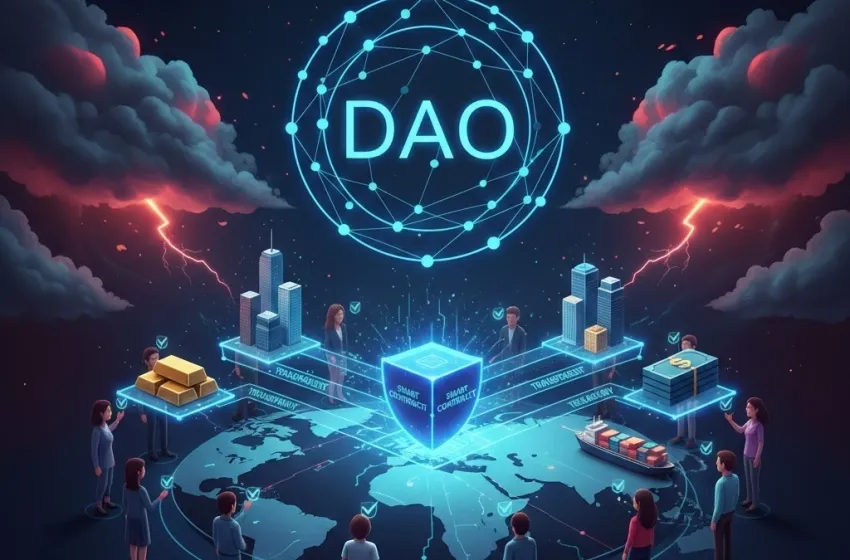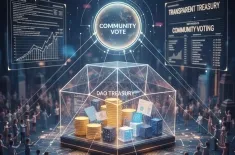Learn how DAOs bridge crypto and real-world assets.
The global financial landscape is characterized by increasing volatility driven not only by economic cycles but also by unpredictable geopolitical risks (GPR). These risks—ranging from trade wars and regulatory shifts to outright conflicts—have the power to shatter traditional diversification models, causing unexpected correlation breakdowns between assets.
For institutions, family offices, and large treasuries, effective GPR hedging strategies are no longer optional; they are a core component of fiduciary duty. Historically, hedging involved allocating to non-correlated assets like gold, specific currencies, or specialized instruments like macro hedge funds. However, the rise of decentralized finance (DeFi) and its organizational counterpart, the Decentralized Autonomous Organization (DAO), introduces a paradigm shift in how large pools of capital can manage and mitigate systemic geopolitical exposure.
This evolution is fundamentally changing the playbook for risk management, replacing reliance on centralized financial intermediaries with programmable, transparent, and globally distributed systems.
Traditional Geopolitical Risk Hedging: The Baseline
Before exploring the novel strategies emerging from DeFi, it is crucial to understand the traditional approaches that have guided risk management in times of geopolitical stress:
- Flight-to-Safety Assets: Investors often rush into assets perceived as store-of-value, such as U.S. Treasury bonds (despite sovereign risk) and precious metals, most notably gold. GPR often drives up the cost of these safe-haven assets.
- Currency Hedging: For multinational entities, hedging involves using forwards, futures, and options to mitigate the risk of adverse currency movements stemming from regional instability or sanctions.
- Sector-Specific Plays: Allocating capital to sectors perceived as insulated or even benefiting from conflict, such as defense, energy, or domestic-focused infrastructure.
- Global Macro Strategies: These active hedge funds aim to profit from large-scale geopolitical or economic events by using derivatives and leverage to bet on interest rate, currency, and commodity movements.
The core vulnerability of these strategies is their reliance on the centralized traditional financial system (TradFi), which is directly exposed to the regulatory and sovereign risks that GPR embodies. Sanctions, capital controls, and bank seizures—all geopolitical weapons—cannot be defended against using the very rails they operate on.
The DAO Revolution: A New Architecture for Treasury Management
A Decentralized Autonomous Organization (DAO) is an internet-native organization, managed by its members and governed by rules encoded in smart contracts on a blockchain. This structure offers inherent advantages for GPR hedging:
The Pillars of DAO Treasury Strength
- Decentralization: By operating without a single legal jurisdiction or central headquarters, a well-constructed DAO is resilient to the geographically targeted actions of any single nation-state (e.g., asset freezing, regulatory bans).
- Transparent Treasury: The entire financial health of the organization—its assets, liabilities, and transactions—is recorded on a public blockchain. This transparent treasury is auditable by anyone in the world in real-time, fostering greater trust among global stakeholders compared to opaque, centralized corporate accounts.
- DAO Governance: Decision-making shifts from a closed board of directors to a global network of token holders. All significant financial and operational decisions, including investment mandates and risk parameters, are made through community voting on proposals enforced by smart contracts. This minimizes single-point-of-failure risk from human error or malicious centralized actors.
The crucial next step is leveraging this resilient architecture for sophisticated decentralized investing.
The Refinement: DAOs Moving from Crypto to Real-World Applications
Historically, DAO treasuries were heavily weighted towards volatile native crypto assets (e.g., governance tokens, ETH, BTC). This created a "circular dependency" risk: if the crypto market dipped due to a geopolitical shock, the treasury value plummeted, and the protocol's governance token lost its collateral value simultaneously.
Managing Large Treasuries and Investment Decisions
To mitigate this, DAOs are rapidly maturing their treasury management practices, seeking diversification and stability by moving beyond crypto-native assets and into real-world applications.
Real-World Assets (RWA) Tokenization
The key innovation is the tokenization of Real-World Assets. This process involves legally structuring an off-chain asset (like a US Treasury bond, commercial real estate, or private credit loan) into a Special Purpose Vehicle (SPV) that issues a corresponding, redeemable token on the blockchain.
How DAOs are being refined to manage large treasuries and investment decisions, moving beyond crypto into real-world applications:
- Stable, Off-Chain Yield: DAOs are now allocating significant portions of their treasuries to tokenized U.S. Treasury Bills and Bonds. These assets provide low-volatility, regulated, and reliable yield, generated from productive, off-chain economic activity rather than volatile token inflation. This provides a necessary stable base for the DAO's operational budget.
- Credit and Real Estate Diversification: Tokens representing fractional ownership of private credit pools or commercial real estate open up historically illiquid asset classes to decentralized investing. A DAO can vote, via its DAO governance structure, to diversify into assets that are fundamentally non-correlated with the crypto market or regional geopolitical events.
- Compliance and Legal Wrappers: The shift to RWA requires DAOs to integrate with regulated legal entities and custodians (the “on-ramps” and “off-ramps” for fiat conversion). The smart contracts now govern the interaction with these compliant TradFi entities, ensuring the tokenized asset is legally sound and redeemable, bridging the gap between the decentralized world and legal reality.
- Advanced Risk Monitoring: DAOs are implementing advanced risk assessment formulas (like Value-at-Risk, VaR, and stress-testing) for RWA exposure, mirroring sophisticated institutional practices but with the added benefit of on-chain transparent treasury reporting.
Geopolitical Risk Hedging with Decentralized Finance
The convergence of tokenized RWAs and robust DAO governance creates unique GPR hedging opportunities:
Non-Sovereign Collateral and Inflation Hedge
Geopolitical events often trigger inflationary spirals, currency crises, and, most critically, the breakdown of trust in centralized authorities.
- Hard-Asset Backing: By backing their governance tokens or stablecoins with tokenized physical gold or investment-grade corporate credit (RWA), DAOs hedge against the devaluation of fiat currency caused by geopolitical instability. This transforms a purely digital token into an asset partially collateralized by tangible economic value, providing a non-sovereign inflation hedge.
- Bitcoin and Ethereum Allocation: While volatile, a strategic, long-term allocation to Bitcoin (BTC) is increasingly seen as a GPR hedge. BTC's decentralized nature, censorship-resistance, and finite supply make it the ultimate digital flight-to-safety asset, especially when capital controls are imposed.
Global Liquidity and Censorship Resistance
A core vulnerability for traditional institutions during a geopolitical crisis is the loss of access to global payment rails (e.g., SWIFT) or the freezing of assets held at centralized banks.
- 24/7 Global Access: DeFi protocols operate 24/7/365, with smart contracts ensuring that liquidity pools and trading remain open regardless of regional crises, time zones, or national holidays. This grants instant, censorship-resistant access to funds and the ability to execute hedges when TradFi markets are shuttered or restricted.
- Decentralized Exchanges (DEXs): These exchanges allow users to swap assets without a central intermediary, providing a critical operational hedge against the coordinated sanctions or shutdowns that could target centralized exchanges.
Algorithmic Risk Management
The automation layer provided by smart contracts allows for a pre-programmed response to geopolitical events, removing human emotion and bureaucratic delay from critical risk mitigation.
- Automated Rebalancing: A DAO can use a set of smart contracts to execute a rebalancing strategy—for example, automatically selling volatile crypto assets and purchasing tokenized U.S. Treasury bonds if a GPR index (sourced via a decentralized oracle) crosses a predefined threshold. This is proactive, transparent, and immutable under the rules of the DAO governance system.
Challenges and The Future of Decentralized Investing
While DAOs offer compelling hedging mechanisms, significant challenges remain, primarily centered on the regulatory and operational bridge to real-world applications:
- Regulatory Uncertainty: The legal status of a DAO and its tokenized RWA holdings is still evolving, creating counterparty risk for the centralized legal entities required to hold the physical asset off-chain.
- Smart Contract Risk: The reliance on smart contracts introduces technical risk. A bug or exploit in the code could compromise the entire transparent treasury, irrespective of geopolitical stability. Rigorous auditing and formal verification are therefore mandatory.
- The "Whale" Problem: Although decentralized, DAO governance often defaults to token-weighted voting. Large holders (whales) can exert disproportionate influence, potentially voting for self-serving investment proposals that run counter to the collective risk-aversion of the community. Innovative governance models, like quadratic voting or delegation to professional sub-DAOs, are necessary to refine decision-making and ensure the integrity of the decentralized investing mandate.
Ultimately, the future of geopolitical risk hedging lies in the fusion of the best of TradFi's stable, income-generating assets (RWAs) with the DeFi infrastructure's transparency, speed, and censorship resistance. DAOs, powered by sophisticated smart contracts and transparent, community-driven DAO governance, are evolving from purely crypto-native experiments into indispensable organizational structures for managing large-scale capital in a geopolitically volatile world. By shifting to a model of decentralized investing underpinned by a transparent treasury and robust community voting, these organizations are building the foundation for a more resilient, globally accessible, and structurally sound financial system.



































